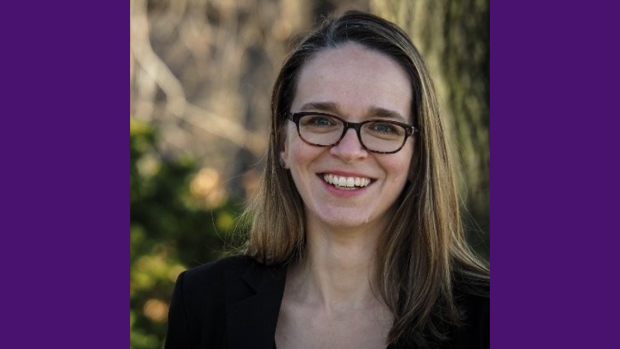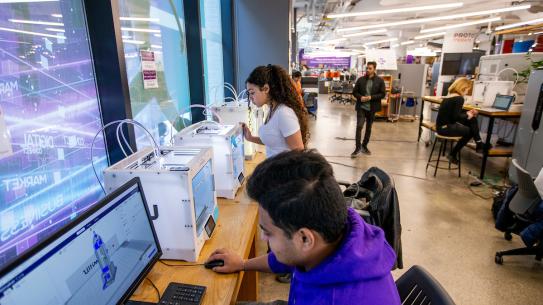Meet Elizabeth Waters, the new director of the NYU Tandon MakerSpace and Experiential Learning Center

After NYU Tandon opened its 10,000 square foot MakerSpace at 6 MetroTech in 2016, observers waxed rhapsodic about its impressive array of equipment — the gleaming rows of 3D printers; the powerful laser and water-jet cutters; the high-speed, high-precision pick-and-place machine; electrodynamic shaker. They used a variety of colorful descriptors to try to convey a sense of the new facility: “part classroom and part lab,” “the fast-beating heart of New York’s burgeoning tech sector,” “a STEM playground,” “the engineering equivalent of Willy Wonka’s factory” ...
Even as the MakerSpace was woven fully into the fabric of the University, that breathless excitement never died down. It’s hard not to step into the space, watch students hard at work on everything from massive model rockets to Martian rovers, see the 3D printers in action, and not get excited.
Tandon has also since launched its Experiential Learning Center (ELC), a sort-of “one-stop shop” that connects students with a wide range of immersive, hands-on opportunities aimed at helping them transform their engineering ideas into reality, tap into their creativity, and prepare for whatever career path they ultimately choose to follow.
This month, the MakerSpace and ELC are welcoming neuroscientist and educator Elizabeth Waters as their new director. Get to know her a little below.
Can you tell us about your background and how you got interested in STEM?
I grew up in the Midwest, in the middle of a generational shift: my mother went to college, and my grandmother was a homemaker who farmed and found ways of making money with home-based entrepreneurial ventures. Each, in her own way, was a wonderful role model.
The men in our community worked with their hands; my uncle was a master plumber, my father worked in a factory, and I knew many mechanics and machinists. In a sense, that was my introduction to STEM.
People in my family have sometimes expressed surprise that I chose the career I did, but given those influences, I think it makes perfect sense.
As far as the specific choice of neurobiology, I trace my initial interest in research to a beloved high school teacher with multiple sclerosis, which disrupts communication between the brain and the rest of the body. My work in outreach and education is due to the late Bruce Mcewen, who did transformative studies of how hormones reshape neural circuits and brain structures. He served the science community throughout this career, and he mentored me when I was a postdoc at The Rockefeller University. His work, along with that of so many other scientists endeavoring to connect research to communities and applications, inspires me and my work in education.
As a native midwesterner, how do you feel about living and working in New York?
I’m originally from Wisconsin and earned my bachelor’s degree from the University of Wisconsin – Madison. After college, many of my classmates headed east or west; I did both. I received a Ph.D. from Oregon Health & Science University and then came all the way across the country for postdoctoral research at Rockefeller University in New York City.
I obviously loved it, because I settled here, and I’ve taught at Yeshiva University, Hunter College, and Weill Cornell Medical. I’ve also worked in STEM Outreach at The Cooper Union.
I think New York — and Tandon — are infused with a really special democratic sense. There’s the idea that we can all learn and grow together, and that resonates deeply with me.
Why did you decide to make a career move away from the neurobiology lab?
I enjoy research but I also believe passionately in the potential of young people. The world has seen scientists and inventors in high school and younger transform their communities and scientific thinking with their work. By applying knowledge about the brain and body to education, we can enhance learning and well-being for young people and adults.
And if I’m being perfectly honest, there’s also the issue of gratification. When you help a student, within a few years, they go out into the world and make their mark. You know very quickly that you’ve had an impact. Progress in the lab is more incremental, so as a researcher you might wait your entire career for a significant breakthrough.
What does neurobiology have to tell us about creating an optimal college experience?
Many people will be familiar with the term neuroplasticity, which refers to the brain's ability to grow new neural networks, change, and adapt. While that happens most rapidly during the earliest years of a child’s life, plasticity is an ongoing process, and the brain never really stops changing as a result of learning and experience.
Neurobiologists have gotten a good understanding of what factors are needed to nurture healthy brains, and we know there has to be a holistic approach. College students need not just formal classroom learning, but opportunities to grow emotionally and socially.
What was your own college experience like?
I was very lucky to attend the University of Wisconsin, which had one of the first student unions in the country. If you’re not familiar with that term, student unions were meant to function as sort of the “living rooms” of a campus — a place where students could gather to find common ground and learn to navigate relationships with people from different walks of life and different majors. I was on my student union’s planning committee, and I realized that if you can encourage someone to try something new for the first time — a new activity, trip, or club, for example, it has a positive effect on their self confidence; they begin to change their preconceived concepts of their abilities. I think that’s what happens in a well-run MakerSpace with a lot of initiatives and projects going on. Take the Vertically Integrated Projects, for example. A team might have a sophomore from civil engineering working alongside a grad student from biomolecular engineering, and that kind of multigenerational, multidisciplinary collaboration is invaluable.
By the way, I’ll just add that I met my husband at the student union, so there’s another benefit.

What is your vision for the future of the MakerSpace and the ELC?
Of course, I have my hopes, but a more important question would be, “What is the school community’s vision?”
I’m 100% committed to the process of getting everyone involved, and that’s going to be my initial priority. The MakerSpace has become an integral part of Tandon over the years, and I want it to continue to evolve and be shaped by its users. And of course, the ELC is poised to add immeasurably to the student experience so that by the time they leave here, every graduate has gotten the experiences they need to thrive.
I was interested to read that within the first two months of opening, the MakerSpace was visited a remarkable 25,000 times. That’s impressive and I hope we continue to see big numbers, but even more important is what happens after all those visitors walk in the door. How long are they staying? How are they interacting with each other? Are they asking increasingly complex questions that show they’re grappling with hard concepts and learning? Importantly, do they feel a sense of belonging? Do they feel that the MakerSpace is their space?
I hope that everyone — faculty members, students, and staff alike — will stop by to chat with me and the wonderful staff here about what they’d like to accomplish and how we can work together to make it happen.





